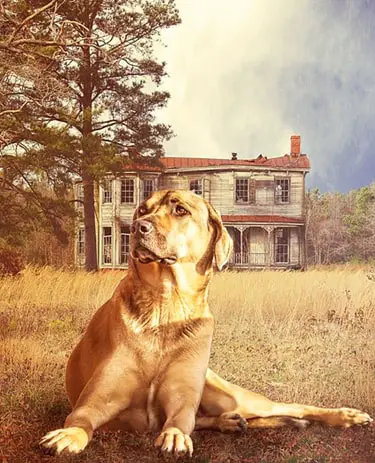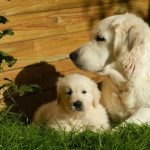
How much does Kangal Puppy cost?
You might have seen breeders charging $800-$1,500 per Kangal puppy. But this price range is actually a bit low, because well-bred Kangals can cost as much as $4,000 each. That may be too much to spend on a puppy but if you’re eager to own a Kangal then it’s worth preparing your finances.
Securing from a breeder if you’re in Turkey is a lot less expensive. The price range is only $600-$800. Kangals can produce from five to 10 puppies per litter. With their large size, it’s not a problem for mother Kangals to carry these many puppies. They also usually give birth naturally.
Most of the Kangals you will see, regardless if they are from a breeder or from an animal rescue, are purebred Kangals. They are rarely mixed with other breeds.
Take note that it can also be expensive raising these dogs. They can be fed raw food, but given their size, this means spending a certain amount for their dry food each day. Homemade food can also be mixed with high-quality kibble. If you’re not sure whether you can handle a Kangal, just consider getting another breed. It’s difficult to convince shelters and rescue groups to take these dogs, given their extraordinary strength. Kangals can be family-friendly pets. But just like with similar breeds that are big and physically strong, there are pros and cons in raising Kangals. It’s important to outweigh them first before applying for adoption.
Where to Get a Kangal Puppy
1. Breeders – if you live outside Turkey, it may be a bit more tedious to find a legit Kangal breeder. There are only very few breeders of these dogs in North America. For those who want to make sure they are getting from a good breeder, at least get some recommendations from big organizations specializing in the breed, including the Kangal Dog Club of America. They have their list of breeders who are members in good standing. These members also adhere to the Code of Ethics set by the club.
2.Shelters – in Turkey, there are shelters specializing in maintaining the dog’s pedigree. Many people from the country see it as their national dog. Many breeders in Turkey are good at complying with the breed standards, especially in terms of color. As per standard, Kangals should only have a solid coat color that is usually in the fawn sable shade. The Kangals are also characterized by a dark mask on their face.
3.Rescues – these facilities are almost the same as shelters, but shelters are normally run by the government while rescues are funded by donations and are run by private organizations. If you’re eager to adopt, you can fill up an online application. The process usually takes weeks. The KDCA will also ask a few questions, including your experience raising a dog, your living arrangements, and the name of your veterinarian.
What You Need to Know about Kangal
-They are not illegal in the United States, but can be pretty dangerous, especially if not trained and socialized early in life. Kangals have very powerful jaws and sharp teeth, no wonder why they are listed as the dogs with the strongest bites. A Kangal has a bite force of 743 PSI which is almost the same bite force as a wolf. There’s no wonder why they were originally used to protect sheep from wolves back in the day.
-They were first bred in Sivas in Central Turkey where they used to guard livestock. The name “Kangal” was derived from the Kangal District, one of the towns of the Sivas Province where these dogs originated. They may not look like it, but history says they are closely related to Mastiffs.
Their relation to Mastiffs is pretty evident, because of their muscular built and strong jaws. American citizens Judith and David Nelson became residents of Turkey and began studying the dogs. The breed has become the subject of their literature. Because of their great interest in the breed, they brought them to the United States in the mid-1980s.
-Thankfully, the Kangal’s coat does not require lots of grooming. With their size, it’s not going to be a piece of cake to groom the Kangal. Also keep in mind that these dogs are heavy shedders. But if you wish to do a quick brush, you can do it once a week. Bathing them can be done every eight weeks or every six weeks if needed.
-They are being compared to Anatolian Shepherds, although the two are different in many ways. Kangals are slightly larger and taller than Anatolian Shepherds. They also have more dense double coats, so the Anatolians are easier to groom because they have fine coats. In many countries, these dogs are seen as two different breeds. But in Turkey, their country of origin, Anatolian Shepherds were already part of the Kangal Shepherd population.
-The Turkish Kangal’s temperament is more on the confident side but they can be intensely sensitive. The Kangal’s intelligence makes it easy to train. It’s also naturally independent, so you will not have a problem leaving it alone for a few hours. Because of its independent nature, the Kangal is very good at protecting their owners and their loved ones. This is the reason why people with farms have the Kangal as one of their options for a family pet.
-They are among the most loyal breeds of dogs you will ever see. The Kangal’s loyalty toward its owners is one of a kind. Once a Kangal treats you as its “leader of the pack,” you can guarantee it will do its best to protect you no matter what happens. The best part is that this dog will shower you with affection in return for taking care of it.
-A secured fence is a must in raising them. The fence should be tall enough to keep the Kangal from escaping. It can be made by a hard material like a solid panel, so your pooch is not able to see on the other side. Even a hole in the fence can seem like an opportunity for the Kangal to go outside; hence it’s also important that the fence cannot be easily ripped off with the dog’s strong teeth and powerful jaws.
-Kangals excel in training that requires mental stimulation and physical ability. Many of these dogs join obedience training and intermediate classes. These training for dogs can be done as early as 6 months of age. Intermediate classes involve teaching the dog how to listen to their human’s commands. If you want your pet to be your guardian especially at night, this training is an essential part of raising your dog.
Where to Find Kangal Puppies for Sale
The Internet is a huge place to find Kangal dogs ready for adoption. But be wary about dealing with people online, because it’s so easy to mistake puppy mills for a real breeder. Here are some of the places where you can have find Kangals:
- https://www.hoobly.com/184/1808/0/ – the website lists all the Kangal puppies you can find in the United States. You can easily find ones near your state by using their “area filter.” All the results already list the price so you can click the ones that are within your budget.
- https://www.chippewavalleykangals.com/ – this website is a member of the Kangal Dog Club of America. It’s owned by Rachel Prince, whose love for dogs began when she was a child. Aside from her experience working at a vet clinic, she also became a certified vet technician in 2009.
- https://www.hexenwaldranch.com/– owned by Babette Turk, a breeder who mainly uses her Kangals to protect their Karakul sheep and Mini Nubian goats. You can visit their small ranch in Santa Cruz from Monday to Friday.
Kangal Health
Any Kangal owner needs to know that these dogs have a long life expectancy, but that does not mean it’s free from any inheritable diseases like hip dysplasia, entropion, and tumors. The breed’s life expectancy is 13-15 years on average, although many Kangals tend to live even longer. It’s very important to know if the dog is at risk of any inheritable disease, so you can identify the treatment early.
It’s important to socialize the dogs early. They can be quite antisocial, which is just natural for their independent nature. However, to prevent aggressive behavior, it can help to expose them to different kinds of places and people. As long as they are kept on a leash, you can bring them to dog parks for a nature walk.
Caring Tips for Kangal Puppies
Baby Kangal dogs should be fed the right amount of puppy food, according to their size. Kangal experts recommend puppy formula only until their sixth month of life, to prevent overgrowth. These pups can grow rapidly and if not given a healthy and well-balanced diet, can suffer from obesity later in life.
Variety is good, because it ensures your pup gets all the nutrients he needs. Your pup can have raw or cooked meat, fruits, and vegetables as well as goat’s milk. You can introduce your pup to a variety of foods at about six weeks of age, or when he’s ready to be weaned from the mother. This is the reason why pups should be at least 8 weeks old before keeping them apart from their mother.
Conclusion
Kangal puppies can be quite expensive, especially if you’re outside Turkey where they are commonly bred. But having a Kangal dog is like having a gem. They are natural protectors who will do their best to keep their “hoomans” safe from predators. Having been flock guardians in the past, these dogs are known for their strong bodies and intellect. A Kangal dog may be the right companion animal for you if you prefer a livestock guardian breed. These dogs have the natural instinct to bark and howl when something suspicious caught their attention.






















